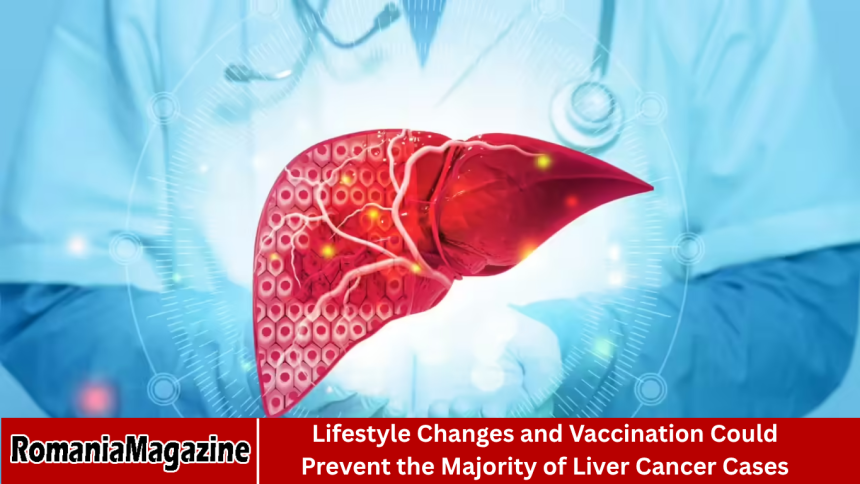Liver cancer, one of the most fatal forms of cancer worldwide, continues to rise in prevalence despite significant medical advancements. The disease, known scientifically as hepatocellular carcinoma (HCC), often develops silently, showing few symptoms until it reaches advanced stages.
- The Global Burden of Liver Cancer
- Hepatitis B and C: The Leading Preventable Causes
- Lifestyle Factors That Influence Liver Cancer Risk
- The Role of Exercise and Metabolic Health
- Public Health Strategies and Early Detection
- Emerging Research and Future Prospects
- The Economic and Social Impact of Prevention
- Frequently Asked Question
- Conclusion
Yet, new research and growing clinical consensus suggest a hopeful message — a majority of liver cancer cases are preventable. Experts now believe that simple lifestyle changes combined with effective vaccination programs could drastically reduce the global burden of liver cancer.
This revelation not only highlights the power of public health interventions but also underscores how individual choices — from diet and exercise to alcohol consumption and smoking habits — can profoundly shape one’s cancer risk.
More Read: Taylor Swift’s Life of a Showgirl Dominates UK Charts and Breaks Multiple Records
The Global Burden of Liver Cancer
Liver cancer ranks as the sixth most common cancer globally and the third leading cause of cancer-related deaths, according to the World Health Organization (WHO). Each year, over 900,000 new cases are diagnosed, and around 830,000 people die from the disease.
The majority of cases occur in Asia and sub-Saharan Africa, regions where chronic hepatitis infections remain prevalent. However, lifestyle-related risk factors — including obesity, diabetes, alcohol use, and exposure to environmental toxins — have caused liver cancer rates to climb in Western nations as well.
The disease often develops in individuals who already have chronic liver damage, known as cirrhosis, which can result from viral hepatitis, alcohol abuse, or fatty liver disease. What makes liver cancer especially concerning is its low survival rate.
Because symptoms typically appear only in later stages, early detection is rare. The five-year survival rate hovers around 18%, making prevention a critical public health priority.
Hepatitis B and C: The Leading Preventable Causes
One of the most striking discoveries in liver cancer prevention research is that chronic viral hepatitis — particularly hepatitis B (HBV) and hepatitis C (HCV) — is the single largest risk factor for developing liver cancer. Combined, these viruses account for approximately 80% of liver cancer cases worldwide.
Hepatitis B Vaccination: A Global Success Story
The hepatitis B virus can be transmitted through blood, unprotected sex, or from mother to child during childbirth. Once infected, many individuals develop chronic hepatitis, which can silently damage the liver for decades before progressing to cancer.
Fortunately, a highly effective vaccine against HBV has been available since the 1980s. The World Health Organization’s global immunization initiative has led to the widespread rollout of the HBV vaccine, particularly in newborns.
In countries where this vaccine has been universally adopted — such as Taiwan and South Korea — liver cancer rates have dramatically declined among vaccinated populations. This success story demonstrates that vaccination is one of the most powerful tools in the fight against liver cancer.
If global vaccination rates continue to improve, experts estimate that up to one million deaths could be prevented annually.
Hepatitis C: A Curable Infection
Unlike HBV, hepatitis C has no vaccine — but it does have a highly effective cure. The development of direct-acting antiviral (DAA) therapies over the past decade has revolutionized HCV treatment. These medications can completely eradicate the virus in more than 95% of cases, halting liver damage and drastically lowering cancer risk.
Public health agencies now advocate for widespread HCV screening, especially among high-risk populations such as individuals with a history of intravenous drug use, those who received blood transfusions before 1992, or those with unexplained liver disease.
Early detection followed by antiviral treatment could prevent thousands of new cancer cases each year.
Lifestyle Factors That Influence Liver Cancer Risk
While vaccination and antiviral therapies address viral causes, lifestyle factors account for an increasing share of liver cancer cases — especially in developed nations. These include alcohol abuse, obesity, poor diet, and tobacco use, all of which contribute to liver damage and inflammation over time.
Alcohol Consumption
Excessive alcohol intake is a well-known cause of alcoholic liver disease (ALD), which can lead to cirrhosis and eventually cancer. Even moderate drinking, when combined with other risk factors like hepatitis or obesity, can elevate liver cancer risk.
Studies show that reducing alcohol consumption — or abstaining altogether — can dramatically lower the likelihood of developing liver-related illnesses. Public awareness campaigns emphasizing moderation, along with government regulations on alcohol marketing, play a vital role in prevention.
Obesity and Fatty Liver Disease
The global obesity epidemic has triggered a surge in non-alcoholic fatty liver disease (NAFLD), now one of the leading causes of liver dysfunction. NAFLD occurs when fat accumulates in liver cells, leading to inflammation (non-alcoholic steatohepatitis or NASH) and scarring.
According to researchers, up to 25% of adults worldwide may have some form of fatty liver disease. Maintaining a healthy weight through regular physical activity and balanced nutrition can significantly lower this risk.
Diets rich in fruits, vegetables, whole grains, and lean proteins — coupled with limited sugar and saturated fat intake — have shown to improve liver health. Losing even 5–10% of body weight can reverse early-stage fatty liver disease and reduce long-term cancer risk.
Smoking
Cigarette smoking is a recognized carcinogen that affects nearly every organ — including the liver. Tobacco smoke contains chemicals that promote liver inflammation and interfere with the detoxification process, compounding damage from other factors like alcohol and viral hepatitis.
Quitting smoking not only reduces the risk of liver cancer but also improves overall cardiovascular and metabolic health, amplifying the benefits of other preventive measures.
Dietary Toxins and Contaminants
Exposure to aflatoxins, toxic substances produced by certain molds in improperly stored grains and nuts, remains a serious issue in parts of Africa and Asia. Chronic ingestion of aflatoxin-contaminated food can significantly increase liver cancer risk, especially when combined with hepatitis B infection.
Improved food storage practices, agricultural regulation, and dietary diversification have proven effective in reducing exposure. Additionally, ensuring safe drinking water and minimizing environmental pollution are crucial to long-term prevention.
The Role of Exercise and Metabolic Health
Regular physical activity supports liver health by regulating blood sugar, cholesterol, and body fat levels. Studies suggest that individuals who engage in moderate exercise for at least 150 minutes per week have a significantly lower risk of developing both fatty liver disease and liver cancer.
Exercise improves insulin sensitivity and reduces chronic inflammation — two key mechanisms implicated in liver carcinogenesis. Even simple activities like walking, cycling, or swimming can offer protective effects when done consistently.
Public Health Strategies and Early Detection
Preventing liver cancer requires a comprehensive, multi-pronged approach that integrates vaccination, education, screening, and lifestyle modification.
Screening and Early Diagnosis
Because liver cancer often goes undetected until late stages, early screening is vital for high-risk populations. Regular ultrasound exams and blood tests for alpha-fetoprotein (AFP) can help detect tumors when they are still treatable.
Those at greatest risk — including individuals with chronic hepatitis, cirrhosis, or metabolic disorders — should undergo biannual monitoring under medical supervision.
Education and Awareness
Raising awareness about the links between lifestyle, infection, and liver cancer is key to prevention. Campaigns that promote vaccination, discourage excessive alcohol use, and encourage healthy living can change population-wide outcomes.
Community-based interventions, such as mobile vaccination units and free screening clinics, are particularly effective in reaching underserved populations.
Access to Care
Equitable access to vaccines, antiviral therapies, and diagnostic tools remains a major challenge, especially in low-income nations. Global partnerships among governments, NGOs, and pharmaceutical companies are essential to closing these healthcare gaps.
Initiatives like Gavi, the Vaccine Alliance, have already made significant progress in expanding hepatitis B vaccination coverage. Continued investment could further reduce liver cancer rates by up to 70% within a generation.
Emerging Research and Future Prospects
The future of liver cancer prevention looks increasingly promising. Advances in genomic research, biomarker discovery, and AI-powered diagnostics are paving the way for earlier detection and personalized prevention strategies.
Genetic and Molecular Insights
Scientists are uncovering how genetic variations influence susceptibility to liver cancer. Understanding these molecular pathways may lead to targeted therapies and improved screening tools capable of identifying individuals at highest risk.
Immunotherapy and Regenerative Medicine
Beyond prevention, cutting-edge treatments like immunotherapy are transforming how advanced liver cancer is managed. Clinical trials are exploring combinations of immune checkpoint inhibitors and other drugs to improve survival outcomes.
Meanwhile, regenerative medicine — including stem cell therapies — holds potential for repairing liver tissue damaged by chronic disease, offering hope for patients who might otherwise progress to cancer.
The Economic and Social Impact of Prevention
Preventing liver cancer is not only a medical imperative but also an economic and social necessity. The cost of treating advanced liver cancer is substantial, placing immense strain on healthcare systems, particularly in low- and middle-income countries.
By contrast, prevention strategies — such as vaccination, public education, and screening — are cost-effective and sustainable. For example, studies show that every dollar spent on hepatitis B vaccination yields up to $20 in long-term savings from avoided medical costs.
Moreover, prevention improves quality of life, workforce productivity, and family stability. It reduces the emotional burden on patients and caregivers alike, fostering healthier, more resilient communities.
Frequently Asked Question
How common is liver cancer globally?
Liver cancer is the sixth most commonly diagnosed cancer worldwide and the third leading cause of cancer-related deaths. Each year, about 900,000 people are diagnosed, with over 80% of cases occurring in Asia and sub-Saharan Africa.
What causes most cases of liver cancer?
The majority of liver cancer cases are caused by chronic hepatitis B and C infections, alcohol abuse, obesity, and fatty liver disease. These conditions lead to liver inflammation, scarring (cirrhosis), and eventually cancer.
Can liver cancer be prevented?
Yes. Up to 70–80% of liver cancer cases can be prevented through hepatitis B vaccination, hepatitis C treatment, avoiding excessive alcohol use, maintaining a healthy weight, quitting smoking, and regular health check-ups.
How effective is the hepatitis B vaccine?
The hepatitis B vaccine is highly effective, providing more than 95% protection against infection. Widespread immunization programs have dramatically reduced liver cancer rates in several countries.
Can hepatitis C be cured?
Yes. Modern antiviral drugs known as direct-acting antivirals (DAAs) can cure hepatitis C in over 95% of patients. Treating the infection early prevents long-term liver damage and reduces cancer risk.
What lifestyle changes reduce liver cancer risk?
Key lifestyle changes include avoiding alcohol, maintaining a healthy weight, eating a balanced diet, exercising regularly, and quitting smoking. Preventing or managing diabetes also helps protect the liver.
Is liver cancer treatable if caught early?
Yes. When detected early, liver cancer can be treated effectively with surgical removal, liver transplantation, or localized therapies. However, early detection is rare, which is why prevention remains the best defense.
Conclusion
Liver cancer remains a formidable global health challenge — but one that can be overcome. The evidence is clear: most liver cancer cases are preventable through a combination of vaccination, early detection, and healthier lifestyles.
Eliminating viral hepatitis through vaccination and treatment, reducing alcohol and tobacco use, managing weight, and improving diet can collectively save hundreds of thousands of lives each year. Governments, healthcare providers, and individuals all play a role in this fight.










